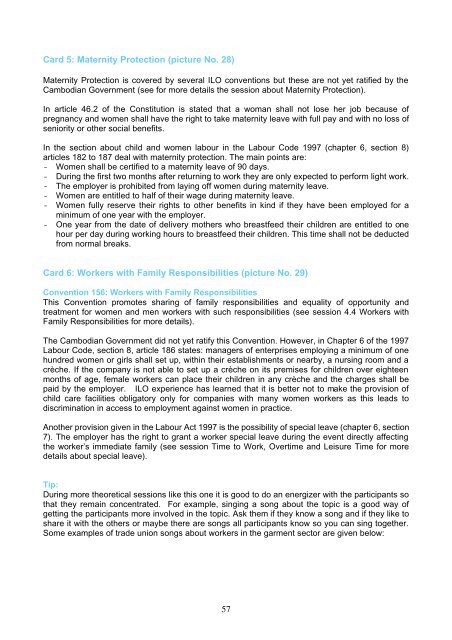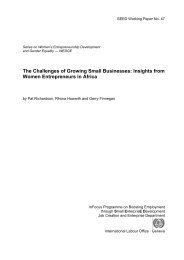manual: women workers' rights and gender equality - International ...
manual: women workers' rights and gender equality - International ...
manual: women workers' rights and gender equality - International ...
You also want an ePaper? Increase the reach of your titles
YUMPU automatically turns print PDFs into web optimized ePapers that Google loves.
Card 5: Maternity Protection (picture No. 28)<br />
Maternity Protection is covered by several ILO conventions but these are not yet ratified by the<br />
Cambodian Government (see for more details the session about Maternity Protection).<br />
In article 46.2 of the Constitution is stated that a woman shall not lose her job because of<br />
pregnancy <strong>and</strong> <strong>women</strong> shall have the right to take maternity leave with full pay <strong>and</strong> with no loss of<br />
seniority or other social benefits.<br />
In the section about child <strong>and</strong> <strong>women</strong> labour in the Labour Code 1997 (chapter 6, section 8)<br />
articles 182 to 187 deal with maternity protection. The main points are:<br />
- Women shall be certified to a maternity leave of 90 days.<br />
- During the first two months after returning to work they are only expected to perform light work.<br />
- The employer is prohibited from laying off <strong>women</strong> during maternity leave.<br />
- Women are entitled to half of their wage during maternity leave.<br />
- Women fully reserve their <strong>rights</strong> to other benefits in kind if they have been employed for a<br />
minimum of one year with the employer.<br />
- One year from the date of delivery mothers who breastfeed their children are entitled to one<br />
hour per day during working hours to breastfeed their children. This time shall not be deducted<br />
from normal breaks.<br />
Card 6: Workers with Family Responsibilities (picture No. 29)<br />
Convention 156: Workers with Family Responsibilities<br />
This Convention promotes sharing of family responsibilities <strong>and</strong> <strong>equality</strong> of opportunity <strong>and</strong><br />
treatment for <strong>women</strong> <strong>and</strong> men workers with such responsibilities (see session 4.4 Workers with<br />
Family Responsibilities for more details).<br />
The Cambodian Government did not yet ratify this Convention. However, in Chapter 6 of the 1997<br />
Labour Code, section 8, article 186 states: managers of enterprises employing a minimum of one<br />
hundred <strong>women</strong> or girls shall set up, within their establishments or nearby, a nursing room <strong>and</strong> a<br />
crèche. If the company is not able to set up a crèche on its premises for children over eighteen<br />
months of age, female workers can place their children in any crèche <strong>and</strong> the charges shall be<br />
paid by the employer. ILO experience has learned that it is better not to make the provision of<br />
child care facilities obligatory only for companies with many <strong>women</strong> workers as this leads to<br />
discrimination in access to employment against <strong>women</strong> in practice.<br />
Another provision given in the Labour Act 1997 is the possibility of special leave (chapter 6, section<br />
7). The employer has the right to grant a worker special leave during the event directly affecting<br />
the worker’s immediate family (see session Time to Work, Overtime <strong>and</strong> Leisure Time for more<br />
details about special leave).<br />
Tip:<br />
During more theoretical sessions like this one it is good to do an energizer with the participants so<br />
that they remain concentrated. For example, singing a song about the topic is a good way of<br />
getting the participants more involved in the topic. Ask them if they know a song <strong>and</strong> if they like to<br />
share it with the others or maybe there are songs all participants know so you can sing together.<br />
Some examples of trade union songs about workers in the garment sector are given below:<br />
57

















